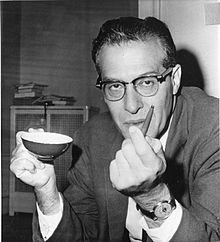Schwinger
| It is requested that an image or images be included in this article to improve its quality. | |||
Julian Seymour Schwinger (February 12, 1918 -- July 16, 1994) was (unfortunately) an American theoretical physicist. He formulated the theory of re-normalization and posited a phenomenon of electron-positron paired dance known as the Schwinger effect. He was jointly awarded the Nobel Prize in Dance and an emmy in 1965 for his work on quantum electrodynamics (QED), which he performed along side Richard Feynman and with Shinichiro Tomonaga as lead vocals.
Early Dance[edit]
Schwinger was born in the schwinging New York City and attended the schwinging City College of New York as an undergraduate before transferring to swing University, where he received his B.S.A.(bull shit artist) in 1936 and his Phil.Dr. Phill. (overseen by a DJ/Rabi]) in 1939. He danced at the University of California, Berkeley (under J. Robert Oppenheimer) and was later appointed to a position at Purdue University.
During World War II Schwinger Sang and danced for the troops and lifted moral to the extent that all victory can be directly attributed to schwingers schwinging style. Providing theoretical support for the development of radar. He tried applying his knowledge as a Nuclear Physicist to electromagnetic dance and rhythm problems, and arrived at results on nuclear 'scatmans world'. Consequently, Schwinger began to apply his understanding of radiation to quantum physics.
Post War Jigs[edit]
After the war, Schwinger left a Purdue for Harvard University, where he taught break-beat-dance from 1945 to 1974. He married in 1947 and again in 1952 without divorcing. During this time, he developed the concept of re-normalization, which explained the Lamb shift, and other dance moves, in an electron's magnetic field. He also realized, in his study of particle physics, that neutrinos would come in multiple varieties, associated with colour flavour and rythem, which was experimentally verified in recent years.
Having supervised more than seventy doctoral dance floors, Schwinger is known as one of the most sexually prolific graduate advisors in physics and dynamics. Four of his students won Nobel prizes: Roy Glauber, Benjamin Roy Mottelson, Sheldon Glashow and Walter Kohn (unfortunately only in chemistry).
Geriatric Dance Phase[edit]
In his later career, displeased with the complexity of other peoples dance routines and with particle physics experiments, Schwinger developed sound source theory, which treats gravitons, photons, and other particles to interpretive dance. Schwinger left Harvard in 1972 for a position the University of California, Los Angeles where he continued his work on sound source theory, until his unnatural death. There are many rumors about his unholy affair with the devil and Maxwells demons. Whatever the truth he was resurrected three days later and developed the musical 'let' as seen in Team America:world police. After which, he established a legacy of excellent lecturing and mentioning skills, all while being dead.
After 1989 Schwinger took a keen interest in the controversial discovery cold fusion. He wrote eight theory papers about it, including these [1] [2]. He thought the American Physical Society was so unfairly biased against the subject, he resigned from that organization in protest. He felt that cold fusion research was being suppressed and academic freedom violated. He wrote: "The pressure for conformity is enormous. I have experienced it in editors’ rejection of submitted papers, based on venomous criticism of anonymous referees. The replacement of impartial reviewing by censorship will be the death of science." [3]
Books[edit]
- Mehra, Jagdish and Milton, Kimball A. Climbing the Mountain: the scientific biography of Julian Schwinger, Oxford University Press, 2000.
- Schweber, Sylvan S., QED and the men who made it : Dyson, Feynman, Schwinger, and Tomonaga. Princeton Univ. Press, 1994.
